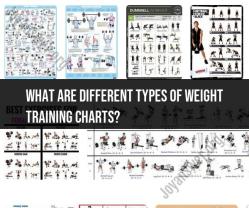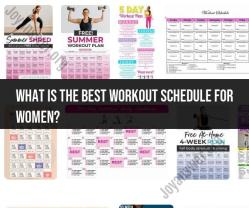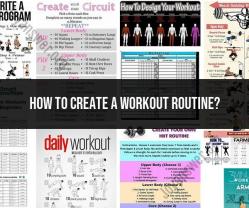What are different types of weight training charts?
Weight training charts, also known as workout charts or exercise charts, are tools used in strength training and fitness programs to track progress, plan workouts, and ensure proper exercise form. There are various types of weight training charts designed for different purposes and aspects of weightlifting. Here are some common types:
Strength Training Routine Charts: These charts outline a specific strength training program. They include a list of exercises, the number of sets and repetitions (reps) for each exercise, and the recommended weight or resistance level. Strength training charts help individuals follow a structured workout plan to build muscle and increase strength.
Progress Tracking Charts: Progress tracking charts are used to record the progress of weightlifting workouts over time. They typically include columns or sections for date, exercise, sets, reps, weight lifted, and notes. These charts help individuals monitor improvements, identify plateaus, and make necessary adjustments to their training programs.
Body Measurement and Fitness Assessment Charts: While not exclusively weight training charts, these charts can be used in conjunction with strength training. They include sections for tracking body measurements like weight, body fat percentage, muscle mass, and various fitness assessments (e.g., flexibility, endurance). These charts help individuals monitor changes in their overall fitness and body composition.
Exercise Technique and Form Charts: These charts provide detailed instructions and illustrations for proper exercise techniques and form. They are useful for beginners and anyone looking to ensure they are performing exercises correctly to minimize the risk of injury and maximize results.
Muscle Group Targeting Charts: These charts categorize exercises by the muscle groups they target. They can help individuals plan workouts that focus on specific muscle groups, making it easier to create balanced and comprehensive training routines.
Training Split Charts: Training split charts help individuals organize their workouts by dividing their training sessions into different days or sessions dedicated to specific muscle groups or exercise types. Common splits include full-body workouts, upper/lower body splits, and push-pull routines.
Warm-Up and Cool-Down Charts: These charts provide guidance on warm-up exercises to prepare the body for weightlifting and cool-down exercises to aid recovery and prevent muscle soreness.
Nutrition and Diet Tracking Charts: Proper nutrition is essential for achieving fitness goals. These charts can help individuals track their daily calorie intake, macronutrient distribution, and meal planning, ensuring they are fueling their bodies appropriately for their weight training regimen.
Injury Rehabilitation Charts: In cases where individuals are recovering from injuries, rehabilitation charts can help track progress, exercises prescribed by physical therapists, and pain levels during workouts.
Personalized Workout Logs: Some fitness enthusiasts create personalized workout logs that include a combination of the above elements tailored to their specific goals and preferences.
These charts can be used in print form, as digital spreadsheets or apps, or even in fitness tracking devices. The choice of chart depends on an individual's fitness goals, training level, and personal preferences. They are valuable tools for staying organized, motivated, and accountable in a weight training program.
Exploring Weight Training Charts: Different Types and Their Benefits
Weight training charts are a valuable tool for anyone who wants to get the most out of their workouts. They can help you to track your progress, set goals, and avoid overtraining.
There are many different types of weight training charts available, each with its own benefits. Here are a few of the most common types:
- Linear progression charts: These charts start with a relatively light weight and gradually increase the weight over time. Linear progression charts are a good option for beginners and people who want to build strength quickly.
- Non-linear progression charts: These charts use a variety of different rep and weight schemes to challenge your muscles and prevent them from plateauing. Non-linear progression charts are a good option for more experienced lifters and people who want to build muscle and strength at the same time.
- Periodization charts: These charts divide your training into different phases, each with its own focus. For example, you might have a phase for building strength, a phase for building muscle, and a phase for cutting fat. Periodization charts are a good option for people who want to achieve specific fitness goals.
Strength Training Made Easy: How to Use Weight Training Charts
Using a weight training chart is simple. First, choose a chart that is appropriate for your fitness level and goals. Then, start by lifting the weight that is specified on the chart for the number of reps and sets that are specified. As you get stronger, you can gradually increase the weight.
It is important to listen to your body and not push yourself too hard. If you are feeling pain, stop the exercise. It is also important to warm up before your workout and cool down afterwards.
Tracking Your Fitness Journey: The Role of Weight Training Charts
Weight training charts can be a valuable tool for tracking your fitness journey. By tracking your progress, you can see how far you have come and identify areas where you need to improve.
Weight training charts can also help you to set goals. For example, you might set a goal to increase your bench press weight by 10 pounds in a month. By tracking your progress, you can see how close you are to your goal and make adjustments to your training as needed.
Overall, weight training charts are a valuable tool for anyone who wants to get the most out of their workouts. They can help you to track your progress, set goals, and avoid overtraining.
Here are some additional tips for using weight training charts:
- Find a chart that is designed for your specific goals. For example, if you are trying to build muscle, you will need a different chart than if you are trying to lose fat.
- Start with a weight that is challenging but allows you to maintain good form.
- Gradually increase the weight as you get stronger.
- Be sure to warm up before your workout and cool down afterwards.
- Listen to your body and don't push yourself too hard.
- Track your progress and make adjustments to your training as needed.
With consistent effort, you can use weight training charts to achieve your fitness goals and improve your overall health.










